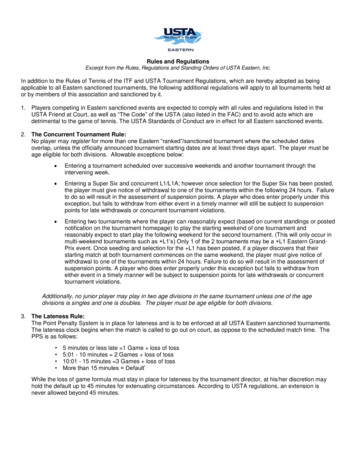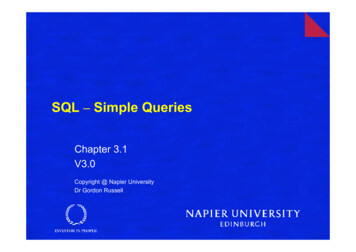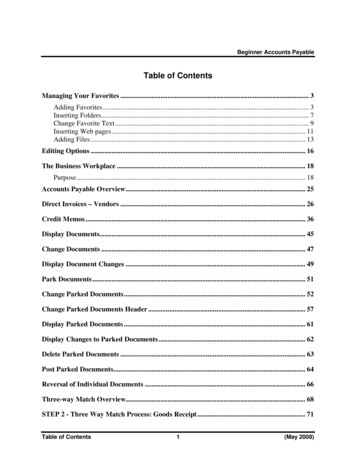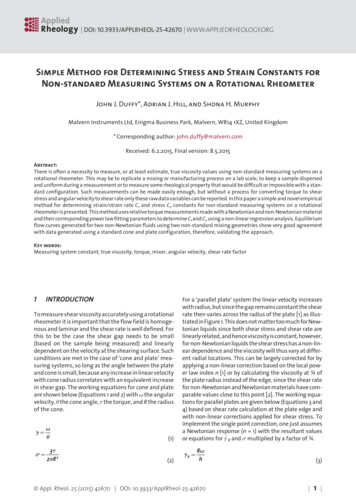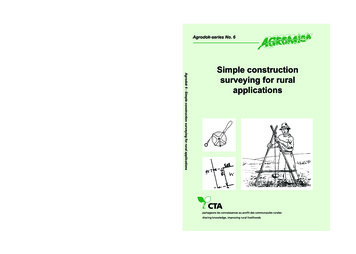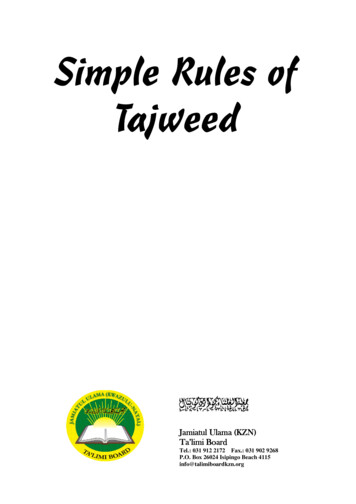
Transcription
Simple Rules ofTajweedßbnäí Ü잌aíØöbáÝÉÜaóïÉ»Jamiatul Ulama (KZN)Ta’limi BoardTel.: 031 912 2172 Fax.: 031 902 9268P.O. Box 26024 Isipingo Beach 4115info@talimiboardkzn.org
Simple Rules of TajweedTitle:Published by:Jamiatul Ulama (KZN)Ta’limi Board4 Third AvenueP.O.Box 26024Isipingo Beach4115South AfricaTel:Fax:E-mail:Website:Skype: 27-31 912 2172 27-31 902 alimiboardFirst edition:Second edition:Third edition:Zul Hijjah1423 /February 2003Ramadhaan1429 / September 2008Rabi-us-Thaani 1431 / April2010For the Esaale - Sawaab of the entire Ummah of Nabi j1.2.3.Open permission is granted for reprinting of this booklet provided that it is not for personalgain and no alterations are made.A humble appeal is directed to readers to offer suggestions, corrections, etc. to improvethe quality of this publication in the future. May Allah Ta’ala reward you for this.The author, sponsors and typesetter humbly request your duas for them, their parents,families, Asaatidha and Mashaaikh.
ContentsIntroduction .1Makhaarij / Special letters .2Full mouth letters .3Open & Closed letters . .4Ghunnah . 5Idghaam .6Ikhfa . 8Izhaar .9Rules of Meem .10Qalb .11Rules of Raa .12Laam of Allah . 13Qalqalah .14Symbols of waqf . 16The rules of waqf (STOPPING) . . 17Mudd. 19
Simple rules of tajweedPage 1IntroductionTajweed literally means to adorn and beautify. In the context of therecitation of the Quraan Shareef, tajweed refers to the correctpronunciation of the letters and applying the various rules ofrecitation.The importance of Tajweed cannot be overemphasized. Therecitation of the Qur’aan Shareef in salaah is compulsory. Often, dueto not reciting the Qur’aan Shareef with Tajweed, the salaah isaffected. It is therefore necessary to learn Tajweed so that theQur’aan Shareef may be recited correctly.Arabic is a very delicate language. A slight mispronunciation cancompletely change the meaning. The word Qalb means heart. If theQaaf in Qalb is not pronounced correctly and instead, it ispronounced as a kaaf, the meaning changes to “dog!” In SurahKausar the word “wan Har” means sacrifice. If the Haa is notpronounced correctly the meaning changes to “scold!” It is thusobvious that the rules of Tajweed must be applied in the recitationof the Qur’aan Shareef.There are many detailed laws of tajweed which take a long time tostudy. However this booklet contains the most basic laws which, iflearnt thoroughly, will enable a learner on the Maktab level to recitethe Quraan Shareef correctly. It must nevertheless be rememberedthat the correct application of the rules of tajweed depends uponlistening to its application by someone who has learnt how torecite the Qur’aan Shareef with Tajweed. Thus the teacher mustclearly recite the various examples to the children, highlighting theparticular rule that is being applied therein. The children must thenbe made to repeatedly practice the examples in the book withadditional examples from the Qur’aan Shareef in order to fully graspthe application of the rule.
Simple rules of tajweedPage 2Makhaarij(Correct pronunciation of letters) Special lettersDo not confuse the letters in the first row with the similarsounding letters in the second row.
Simple rules of tajweedPage 3Full mouth lettersThese seven letters will always be read with a full mouth. #" ) ! ( " ( ) * , . ) ! " / 0 % & '! 7 45 "6 8"1 23 )/# 1 " 0/8 1 ( )/ )9 :* ; & C ? 4@ 6 * A B/@)" C H" ED F B FGD ')7 4' F I , JB 3 & HC K G )/ L & A J"%/G A " G )/-) / * "6
Simple rules of tajweedPage 4Open letters MC Pull the letter for the duration of one Alif N; OD )9D D QOPR/; ) S ) & " L& " H" U* # א 9WV O P& " )& " /; )/ . X F I Y 4D 2F L W # D 4 2Z [Closed lettersBe careful not to drag a closed letter " L B\ N; 4 7 B C " I 0/ 6 [ 7 ] 0 [ * H N ) N; 23 2 1 L / 6 "N 4 ] 2a 0 1 b * # c 7 d
Simple rules of tajweedPage 5GhunnahWhenever Noon or Meem has a Tashdeed, make Ghunnah(a long nasal sound). /( 4 0 eNA" \ P e f Ib /Ib c N N"X / (6 / I) WD) /( P / 0" B/ I) /( 4 0/ (8 f )/ (8 / 6 C g I5" )/ L 1"4 hV " Y ) /; P / 0 F P i / ( ) / P i B/; I) C " Nj P& " 4 d I )C 3e (G "6 / I) 1 6
Simple rules of tajweedPage 6IdghaamIf after noon saakinletters( c)or tanween(e k )C c M appear then make idghaamthe(join theletters) and make ghunnah (a long nasal sound). For e.g.l" & ". 2 1 6If after noon saakin or tanween the lettersl Bappearthen join the letters and do not make ghunnah.For e.g.e C " B c3" ) 1 6 eN 8 B m"l& ". 2 1 6 " no 2 1 6 7 ( ] 2 1 ( 0p :* 2 *k q fO@ " P 1 6 e e f dA /P f46/ 2 r h 6& 2" B3" " N 3 2S P 1 4 0 e f ( / P r h 6& 2
Simple rules of tajweed/ 6 k a Q 6Page 7n 6 1 6 3 V 6 1 6 ] " l & " / 6 [U* ; @ "6 /kOG" As )C 1 6 3 )C / 6C 3 ) C C N t BC 1 6 M3 ; 2C *k Q * " 2 c i C /."45 2 c * o " 2 1 6 /H/ 0"BC /k( D e3 u 6 3e ( 8 f 6/ . ) & 2 C k f I ] )
Simple rules of tajweedPage 8IkhfaIKHFAA: If any of the following letters appear after NoonSaakin or Tanween, Ikhfaa (a nasal sound equal to one alif)should be made. m v w 1 N;" 4 ]u 0 7 u 1 6 N; Ha Ak " k " " x q gOP NX f4 ) NYPJ c/VP i y;) k B/ Pf L / f A / P" 3 G " H r h 6& 2 & b" 1 6 R 4". X 1 6e f ( ey"Y "
Simple rules of tajweedPage 9IzhaarIf any of the following letters come after a Noon Saakin orTanween, Izhaar will be made. :Izhaar means to recite without a nasal sound(without pulling).& # 1 6 m *G P C R ( ] P J" W I6 y', 16 16 J 1 6eN j 8 eN 4 7 L/ L *k z eN 4 F q *k , /k6& *e d# eN 4 / I 23 /8k & " P" B 1 6 c r D c N ) % r 1 6 Nj
Simple rules of tajweedPage 10Rules of MeemIDGHAAM: If a Meem appears after Meem Saakin, ghunnawill be made." F I6 NjI H / 2 /6 Nj" )" Nj ] 6 N;" P c& " 4 * "6 Nj" ) IKHFAA: If a Baa appears after Meem Saakin, Ikhfa will bemade N; L N;" L B1 I6 { "( L N" / 6C " N; I L Nj" 8/ 0D L N E/ Y ] 2IZHAAR: If any letter besides Baa and Meem appears afterMeem Saakin, do not make ghunna.e*b J N;" 4 0 F 0 N" 3 7 ]u 2 N )J Nj" " I 2 Nj" )
Simple rules of tajweedPage 11QalbIf the letter % appears after Noon Saakin or Tanween, Qalbwill be made. Qalb means that the Noon or Tanween willchange into a 3 ] L 1 ۢ 6 1 ; H& " "L 1 ۢ 6 7 }t* F I L 1 ۢ 6 75 L 1 ۢ 6 /; 4 . L 1 ۢ 6 f A / I)/ L ۢ /k] OV I ) / ( L ۢ 3k L J / ( L g ۢ O Pۢ e L 1 h (@ "6c / ( 2Z/ W L *e ۢ @ O I"6 I L /ۢ 2 א / * @ L ۢ f 2* N; Y IV ) / L ۢ / )f I L 1 ۢ
Simple rules of tajweedPage 12Rules of RaaRaa with a Fatha (Zabar) or Dhammah (Pesh)ORRaa Saakin with a Fatha or Dhamma before itwill be read with a Full Mouth. N; 6 * H 7 B C k* z * H N ) c& " * " 2 " BZ R "* "6 C * %* LF L BRaa with a Kasrah or Raa Saakin with a Kasrah before it willbe read with an Empty Mouth. N" Br P * q 1 6 * # 1 6 * Y C / P B/ P F 0 %* AB & z" C * d )/ L"Br"P * Y P/ 0% * q * 3 "6
Simple rules of tajweedPage 13Laam of AllahIf a Dhammah (Pesh) or Fatha (Zabar) comes before theword “Allah”, it will be read with a Full Mouth (Tafkheem)." ED & " D" E Z P ED *" -" ED N Y# ED l" & " B ED F 4 " ED F BIf a Kasrah (Zer) comes before the word “Allah”, it will beread with an Empty Mouth (Tarqeeq). ED F 0 ED N V L ED 3" (G ) J ED 3 I 1 6 " ED 7 " DE / L " & " J ED / 2 א L
Simple rules of tajweedPage 14Qalqalahb If any of the letters of (3"y@ " )w % has asaakin or jazam, Qalqalah will be made. Qalqalah meansto make an echoing sound. "I . 2 *. L " N; ( ]z J e f I h (@ "6e7 d8 *e dA *e u 0"NV "k f O@ " P 7 2* db " * u HMs ]b *) 3 . ) 3 )& " 2 N )C 3 4 2 N ) e B3 /P3 d / I 4 ]u H N;" Y 4 d ! . P
Simple rules of tajweedPage 15The same rule applies if the Saakin is due to Waqf (stopping). K 4# y C K4 0 y;)e & " Ij )e38 J ""w C*d) / Lwe S 6 BeK 2* 8 & " ]" "3 (-)"K8 yV "6e Gwe * 8 w C *" " LTake care: When making Qalqalah, take care that a Harkat should not be read(Zabar, Zer or Pesh) is not created. e7 d8ase7 d8
Simple rules of tajweedPage 16Symbols of Waqf (Stopping(Stopping)topping)﴾﴿ [ These signs indicate that you muststop.ۤۡ ۡۡ ' ﻣﺎ ۡ ۡ ﻞ ﺑ ٖﻪ ﻛﺜ ﲑ ﻳﻦ ﻛﻔﺮ' ﻓﻴ ﻘﻮﻟ ﻮ! ﻣﺎ ﷲ ﺑ ٰﻬﺬ ﻣﺜﻼ ﻳ ﻀ .ۡۡۡ ۡ ﺑ ٖﻪ ﻛﺜ 1﴾﴿ ﻞ ﺑ ٖﻪۤ ﻻ ﻟ ٰﻔﺴﻘﲔ 'ﻳﻬﺪ 'ﻣﺎ ﻳ ﻀ 0 ﲑ w 7A These signs indicate that you havethe option to stop.ۡ.ٰ ﻣ ۡﻦ ﻇﻬ ۡﻮ ﻫﺎ 'ﻟ : ﺒﻴ ۡﻮ . ! ﺗﺎۡﺗﻮ ﻟ . ﱪ ﺑﺎ . 'ﻟ ۡﺲ ﻟ ' ﺗ ﻮ 4 ﱪ ﻣﻦ ﺗ ٰﻘﻲ ﻟ ﻦ ﻜ . ' ﺗﻘﻮ ﷲ ﻟﻌ ﻠ B ﻮ ﺑﻬﺎ . ﻦ ﺑ . ﻣ : ﻟﺒﻴ ۡﻮ ! ﺤ ۡﻮ ﻜﻢ ﺗ ﻔﻠ fO C fYj These signs indicate that a slightpause should be made withoutbreaking the breath.ۡۡ. .M ﻮ . ﻟﻘ N ﺮﻧﺎ ﻋ . ﻨﺎ ﻓﺎﻧﺼ Lٰ ﻮﻟ . ﻧﺖ ﻣ E ﺣﻤﻨﺎ ' E ﺮ ﻟﻨﺎ . ' ﻏﻔ E ﻒ ﻋ ﻨﺎ ' ﻋ ٰ . ﻟﻜﻔﺮﻳ ۡﻦ ZDo not stop.ۡ. ﺒﻠ . ﻳۡﻦ ﻣ ۡﻦ ﻗ ' ! ﻮ . ﺮﻋ . ﻓ R ٰ S ﻛﺪ P
Simple rules of tajweedPage 17Rules of Waqf (Stopping(Stopping)topping)1. The general rule of waqf is to remove the harkat of thelast letter and replace it with a sukoon / jazam.p :& ) 9 :* ,K 4 0 yV "7 " " B y; )3e 8 :& ) :* ,K 4 0 yV 7 " " B y; )3 8 2. If the last letter has a fathatain / do zabar, take out onefatha / zabar and read the alif after it.(If there isn’t an alif, add one).k tS b k t3 P*k o P k a 4 /kL/V 8 *k V " 2/k( ( 8 tS b t3 P* o P a 4 / L/V 8 * V " 2/ ( ( 8 3. If the last letter is a round taa , change it to a (small) haa and put a sukoon / jazam on it.k U* . L k f 6 /8 f )/ e U* r H e f O b B f q / ,k f Ib :* . L W 6 /8 W )/ :* r H W O b B W q / , W Ib
Simple rules of tajweedPage 184. If the last letter is an alif with a fatha / zabar before it orif the last letter has a sukoon / jazam or the last letter hasa fatha muqaddara / khara zabar, no change will takeplace when making waqf. * " / / / / I L / a HFD4 FuD * o 8" * " / / / / I L / a HFD4 FuD * o 8" 5. If , , comes before the last letter, then pull slightlywhen making waqf. 2* " & # 1 ] YV P e B& j" q c/ L 1" D(8 *) m 2* " & # 1 ] YV P B& j" q cn L 1 D(8 *) m6. If the last letter has a tashdeed, pull a little when makingwaqf. "6 g 6 e7@ 0 y"* O 6 ec b " 8 B ' H *O 6 c b 8 B ' "6 g 6 7@ 0 y H
Simple rules of tajweedPage 19MuddThere are two types of Mudd: 1. Short Mudd 2. Long MuddShort Mudd - Pull for 3 AlifsLong Mudd - Pull for 5 Alifs N;" H b " o 2 1 6k V P 7 2 t* s I L n I H א l א N"Y P / D p WX BCGD h DR t* ."O 4 )1 D Y 6 3 "6K" G ) b g D 2" :&D L " 8 s P& b " ED א " %t C3) *q 1 2* r) D 7 ]D ;D !K V N8DٓٓۤۤWWٰٰ0 T ﻫ ﺆﻻ X 'ﻻ T ﻫ ﺆﻻ X ﻻ ۡ ۤ ﷲ T ۡ'! ﻻ ! [ ﺸﺂ T ' ﻣﺎ \ﺸﺂ
Simple rules of tajweedPage 20Notes
Rules of RaaRules of Raa Raa with a Fatha (Zabar) or Dhammah (Pesh) OR Raa Saakin with a Fatha or Dhamma before it will be read with a Full Mouth. N;ˆ 6ˆ *H 7 B C k* z *H N) c& " * "2 *"6 C" BZ Rˆ " % * *ˆL Fˆ LB Raa

